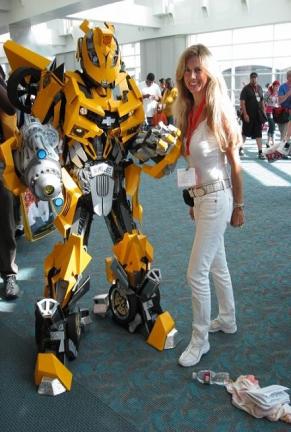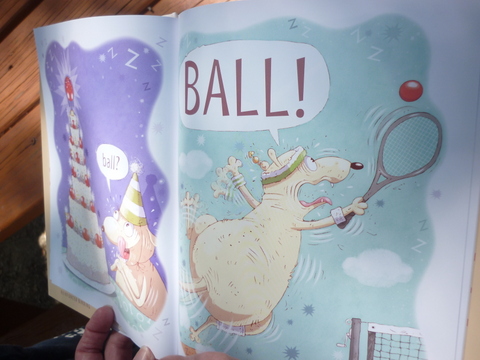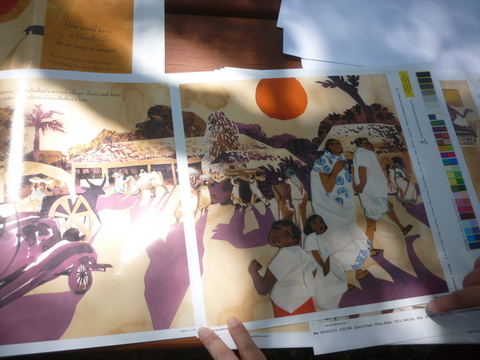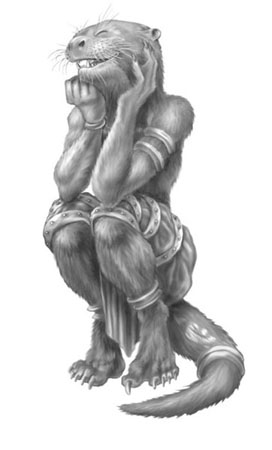For some children’s book artists this interview might be a little hard to hear and to bear. For others it could offer new hope.
Jo Ann Miller of Serbin Communications’ Directory of Illustration suggests that illustrators think a little bit outside the book.

Jo Ann Miller of Sebin Communications’ Directory of Illustration greets a Transformer at this year’s San Diego Comic Con
You’ve seen artists’ directories — glossy annuals combined with online portfolio galleries where artists or their reps buy display ads. The Directory of Illustration is the dreadnought battleship of illustration directories, aiming its marketing guns at the entire waterfront of graphic arts, not just children’s publishing. That means children’s products, fashion and cosmetics merchandising, corporate promotions, retail advertising, medical illustration, the animation industry and even landscape design — to name a few.
With the Toy Industry Association as a partner, the Santa Barbara, Ca. based publisher also produces Play! “Illustration for Toys and Interactive Games — a website for hiring toy and interactive game artists.
Best of Photography Annual, the Medical Illustration Sourcebook , and Designer Jewelry Showcase are some other annuals from Serbin Communications.
The Directory of Illustration is going on its 27th year. It’s not cheap being in a dominant industry directory . $2,500-$2,600 gets you a full page with 30 portfolio images. Artists re-up year after year, sometimes sharing pages with others who have the same art rep or agent. Program benefits include, hardcopy distribution to 20,000 illustration buyers and art directors, national online advertising, free website design and cross promotion with Contact, a leading talent directory in the UK and Europe.
If you’re like me and many freelancers who keep a death grip on their wallets, you might question spending the equivalent of a small book advance every 12 months to participate in a showcase with a few hundred of your keenest competitors.
Why do it when you can upload images for free to your Flickr page, WordPress.com blog, SCBWI portfolio, or favorite art web ring. Or mail out your own printed Christmas postcards to the small ranks of active children’s book editors?
You can do it to reach markets for your art that you might never have thought of, says Jo Ann.
So lets let her talk us through some of this.
What does the “Directory of Illustration” offer artists who have their hearts set on illustrating children’s books?
I love children’s book illustration and I work with many children’s book illustrators in the directory, but they also do other things.
The children’s publishing market can pay very well but advertising and design generally pays better. The market for children’s book art ebbs and flows. The in-between target group — ages 12 – 15 (particularly girls) — based on what iour clients tell me, happens to be very active.
So the first question I always ask illustrators is, ‘Who is your target audience? What is your age group?’
New York illustrator Lisa Falkenstern generally works in oils, but also in egg tempera, acrylic, and digitally. Here’s her directory portfolio page. After 20 years as a professional illustrator,she’s just finished illustrations for The Busy Tree, by Jennifer Ward for ages 5-8, published by Marshall Cavendish. She’s also written and illustrated her own children’s work that is currently in production. Treat yourself to a look at her magical website.
Is that what you told aspiring illustrators in the Portland chapter of SCBWI, when you were invited to speak to them recently?
We discussed how the art buyer looks at the target audience and the age group within that target audience, and things like color — the palette. Right now purple and magenta colors dominate in advertising, so illustrators showing a lot of purple in their portfolios are getting looks.
I can remember a few years ago when the Razor Skooter first appeared in stores — if an illustrator had a child on a razor scooter, he was appealing to art buyers who were looking to market to that age group.
When Starbucks was ready to launch its franchises around the country every illustrator who had an image of a coffee cup on his page in our directory was getting calls.
So you’re saying it comes down to the marketplace.
Yes. So if you understand how to tell a story and emotionally connect with people in the pages of Scholastic magazine or a picture book — can you make the attitude shift to collaborate with an art buyer or a designer to put together a product or package?
If you can, if you can interpolate the needs of the art buyers and you’re not afraid of taking art direction or design direction, you’ll strengthen your repertoire and make a little more money.
Your children’s illustration on a children’s clothing hang tag.
Tom Kerr, a directory artist based in Omaha works in acrylic, colored pencil, watercolor. pen and ink and digital media. Here’s his directory portfolio page. His light humorous style has found its way into newspaper editorial cartoons, magazines, animation characters and 25 books, the most recent being “Math Wizardry for Kids” by Margaret Kenda and Phyllis S. Williams (Barron’s Publishing.)
New meadows to graze
So your message to artists is, try to expand into different venues?
Over the years I’ve seen illustrators getting their names in editorial publications because they were doing storytelling art for merchandise packaging. I’ve seen it work the other way, too — illustrators’ success grow from the editorial audience to the design audience. That’s because the same age group that buys a book will buy the game, the cereal, the clothing and the McDonald’s happy meal set with the character toy and all the packaging.
The art buyer looks at the children’s market as being intertwined with comic books, graphic novels, sci fi market and merchandising and advertising. I don’t think illustrators are always thought of as having a style. They’re thought of in terms of solving a problem.
You put an image on a book to sell the book…the magazines…
the product… the ad campaign.
So it’s not just storytelling, but it’s also selling a product.
If you can show the skill set beyond storytelling, you broaden your appeal to the ad agencies and design shows. That means if you can illustrate a story, but you also have certain digital skills, some animation or flash, or modeling and 3-D skills, you’ll often be considered for a variety of products.
Is there a place in this commercially driven universe for the traditional illustration, rendered with real paint on real paper?
Digital art seems to get more attention than traditional art. It’s very popular for packaging and creating characters. It’s used to communicate just about anything. Digital artists get a lot of people looking in their portfolios.
But there are always people — right now especially — looking for that nostalgic, hands on feel in the art. Watercolor, draftsmanship, the simple pen and ink line have a more important place than they had three years ago. Everybody’s been touched by someone who’s lost a job. People are going through a tough time. They want an emotional comfort level. That means images that strike an emotional, warm and fuzzy feeling, that appear hand-made rather than in your face and MTV-like.
Would you want your child, your three year old exposed only to that hard edged computer or Disney- look?
No!
There’s always a need for the humaneness in visual images — particularly in an economy that’s struggling. And it’s often found in pictures done in the very traditional mediums like watercolor and pencil. I think artists of that old school style have shied away from promoting themselves.
When they should be embracing opportunities to showcase their art.
So we have artists in the directory like John Parra whose fine art/folk art traditional style finds outlets in many kinds of publications — including children’s books.
Gracias Thanks by Pat Mora with illustrations by John Parra
who works in acrylic, oils and digitally. See his website.
How to tout one’s own horn in the arts?
In her own life Jo Ann ran up against this vexing question.
At age 18 she became a national dance champion (having studied dance since the age of 5).
She won the title of Miss Dance of America, which led to an invitation to enter the Miss America Pageant, where she tied for 11th place.
At 19, she won Miss New York State. She entered the Fashion Institute of Technology in New York City with her scholarship from the pageant. “I wanted to dance but I never knew how to promote myself except to audition,” she says. “My father wanted to help. He was an engineer. He put together a business card for me that said ‘dancer, beauty pageant winner.'”
After college studies in marketing she worked as a Ford Model in New York City. But an injury while filming a TV commercial forced a career shift — she launched a public relations firm on Rodeo Drive in Beverly Hills, California.
Her client base came to include Vanessa Williams and President Ronald Reagan.
Over the last 17 years Jo Ann has worked matching illustrators and designers with buyers and art directors, first with the now gone artists directory American Showcase, then Serbin Commuinications and The Directory of Illustration.
-

Page illustration by Tom Kerr
Page illustration by Tom Kerr from the Directory of Illustration
Jo Ann, is it true that the Directory of Illustration is not for everyone?
Not every children’s book illustrator will be right for the Directory of Illustration.
Not all illustrators have the ‘want to’ or the ability to understand the buyer’s needs.
And if the illustrator doesn’t get it and he’s not seasoned enough to deal with a call like that then it’s embarrassing for us. Our job is trying to match qualified art buyers with qualified illustrators. If they don’t match, we’re not doing our job.
If the illustrator is too amateurish or hasn’t developed his ‘voice,’ he’s not ready for our program.
We don’t want artists spending money for a program they’re not ready for.
We’re not the vehicle to ‘break in’ with.
I’ve turned so many people away, but with generous insight. Part of the consulting I’m doing is guiding these artists. Most want honest feedback, some idea of how they fit into the industry.
If someone wants a discussion prior to investing in the directory or any kind of marketing program — I can consult with that person and help them out a lot. When I work with an illustrator, I make recommendations depending on the artist, trends and many criteria. I don’t tell someone what to do. I guide them, and send them back to the drawing board again and again.
She offers one on one consultations — usually in the summer months.
Illustrators are welcome to contact her by e-mail at: joannmiller@serbin.com
She recommends that they send a short introduction and an image or two ( jpgs or a site link.) And she encourages all artists to check out the Directory of Illustration website . “There’s a lot to be seen there,” she says.
Don’t forget two big Texas conferences!
Austin SCBWI comes first with Destination Publication set for Saturday, January 30, 2010.
The one day event features a Caldecott Honor Illustrator (Marla Frazee) and Newberry Honor author Kirby Larson. The lineup also includes the wonderful illustrator Patrice Barton doing portfolio reviews, Mark McVeigh an agent who represents authors, illustrators and graphic novel creators for the adult and children’s markets, and editors Cheryl Klein, Lisa Graff and Stacy Cantor (who did work on all of the Harry Potter books!)
Read more about everyone here. Get the the registration form here. Hurry, the event and only a few portfolio
review sessions are left.
Houston SCBWI has set its conference for Saturday, February 20, 2010. Headliners include acclaimed author of short stories, funny picture books, Native American fiction, and YA Gothic fantasies, Cynthia Leitich Smith, Creative director at Henry Holt Books for Young Readers Patrick Collins and editors Ruta Rimas, Alexandra Cooper and Lisa Ann Sandell. Download their bios, conference info and a registration form here.

P is for Pinata by Tony Johnston and illustrated by John Parra,- courtesy John Parra and The Directory of Illustration.
* * * * * *
Check out the great drawing instructional videos by Matthew Archambault at Drawing-Tutorials-Online.com
Mark Mitchell teaches children’s book illustration at the Austin Museum of Art Art School and online . The next semester of classes begins at the school’s Laguna Gloria campus next month, with Children’s Book Illustration I, January 27 – March 10, 6-9 p.m.
Children’s Book Illustration II March 23 — April 20, 6-9 p.m.
Mark teaches an online course on drawing and painting for illustration “Make Your Splashes; Make Your Marks!” that is self-paced and starts whenever you’re ready. Learn more here.
* * * * * *
























